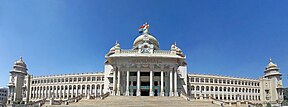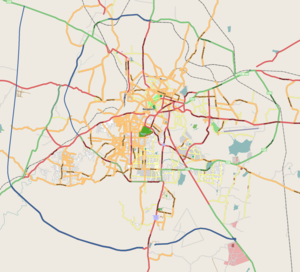A request that this article title be changed to Bengaluru is under discussion. Please do not move this article until the discussion is closed. |
Bangalore | |
|---|---|
| Bengaluru | |
| Nicknames: | |
| Coordinates: 12°58′44″N 77°35′30″E / 12.97889°N 77.59167°E | |
| Country | |
| State | |
| Districts | Bangalore Urban |
| Established | 1537 |
| Founded by | Kempe Gowda I |
| Government | |
| • Type | Municipal Corporation |
| • Mayor | Vacant |
| • Corporation Commissioner | Tushar Giri Nath, IAS[1] |
| Area | |
| • Metropolis | 741 km2 (286 sq mi) |
| • Metro | 8,005 km2 (3,091 sq mi) |
| Elevation | 920 m (3,020 ft) |
| Population (2011)[5] | |
| • Metropolis | 8,443,675 |
| • Rank | 3rd |
| • Density | 11,000/km2 (30,000/sq mi) |
| • Urban | 10,456,000 |
| • Rank | 5th |
| Demonyms |
|
| Time zone | UTC+05:30 (IST) |
| Pincode(s) | 560 xxx |
| Area code | +91-(0)80 |
| Vehicle registration | KA:01-05, 41, 50-53, 57-61 |
| GDP (PPP) | $359.9 billion[9][10] |
| Official language | Kannada[11] |
| Website | www |
Bangalore (/ˈbæŋɡəlɔːr, ˌbæŋɡəˈlɔːr/ BANG-gə-lor, -LOR), officially Bengaluru (Kannada: [ˈbeŋɡɐɭuːɾu] ; ISO: Beṁgaḷūru), is the capital and largest city of the southern Indian state of Karnataka. It has a population of more than 8 million[5] and a metropolitan population of around 15 million,[6] making it India's third most populous city and fourth most populous urban agglomeration. It is the most populous city and largest urban agglomeration in South India[citation needed], and is the 27th largest city in the world.[12] Located on the Deccan Plateau, at a height of over 900 m (3,000 ft) above sea level, Bangalore has a pleasant climate throughout the year, with its parks and green spaces earning it the reputation of India's "Garden City".[13] Its elevation is the highest of India's major cities.[14]
The city's history dates back to around 890, as per the old Kannada stone inscription found at the Nageshwara Temple in Begur, Bangalore. In 1537, Kempé Gowdā, a feudal ruler under the Vijayanagara Empire, established a mud fort, considered the foundation of modern Bangalore and its oldest areas, or pétés, which still exist. After the fall of the Vijayanagara Empire, Kempe Gowda declared independence; in 1638, a large Adil Shahi Bijapur army defeated Kempe Gowda III, and Bangalore came under Shahaji Bhonsle as a jagir, which later became his capital. The Mughals later captured Bangalore and sold it to Maharaja Devaraja Wodeyar II of the Kingdom of Mysore.[15] When Haider Ali seized control of the kingdom, Bangalore's administration passed into his hands.
The city was captured by the British East India Company after victory in the Fourth Anglo-Mysore War (1799), which then returned administrative control of the city, along with the kingdom, to Maharaja Krishnaraja Wadiyar III. The old city developed under the dominions of the maharaja. In 1809, the British shifted their cantonment to Bangalore, outside the old city, and a town grew up around it. Following India's independence in 1947, Bangalore became the capital of Mysore State, and remained the capital when the state was enlarged and unified in 1956 and renamed Karnataka in 1973. The two urban settlements of Bangalore, the town and the cantonment, which had developed as independent entities, merged into a single urban centre in 1949. The existing Kannada name, Bengalūru, was declared the city's official name in 2006.
Bangalore is considered to be one of the fastest-growing global major metropolises.[16][17] Recent estimates of the metro economy of its urban area has ranked Bangalore as one of the most productive metro areas of India.[18][19] The city is considered the pivot for high-technology-based heavy manufacturing industry, with numerous large multinational technology corporations setting up their headquarters there. It is home to many top-tier engineering and research institutions. Bangalore is known as the "Silicon Valley of India" because it is the nation's leading software exporter as well as a major semiconductor hub.[20] Several state-owned aerospace and defence organisations are in the city. The presence of numerous notable sporting arenas in Bangalore makes it one of the country's sporting hubs.
- ^ "New BBMP Chief Commissioner inspects infrastructure projects". Deccan Herald.
- ^ "History of BBMP". Bruhat Bengaluru Mahanagara Palike (BBMP). Archived from the original on 2 November 2020. Retrieved 20 May 2021.
- ^ "Introduction - BMRDA". Bangalore Metropolitan Region Development Authority. Archived from the original on 20 May 2021. Retrieved 20 May 2021.
- ^ H.S. Sudhira; T.V. Ramachandra; M.H. Bala Subrahmanya (2007). "City Profile — Bangalore" (PDF). Cities. 24 (5). Bangalore: 382. doi:10.1016/j.cities.2007.04.003. ISSN 0264-2751. Archived from the original (PDF) on 24 December 2012. Retrieved 13 October 2013.
- ^ a b Cite error: The named reference
census2011.co.in Bangalorewas invoked but never defined (see the help page). - ^ a b Cite error: The named reference
UNcities2016was invoked but never defined (see the help page). - ^ "INDIA STATS : Million plus cities in India as per Census 2011". Press Information Bureau, Mumbai. National Informatics Centre. Archived from the original on 30 June 2015. Retrieved 20 August 2015.
- ^ https://www.thehindu.com/news/cities/bangalore/silicon-binaries-language-culture-and-identity/article26225844.ece
- ^ "Deep Dive City Bangalore, India" (PDF). Transformative Urban Mobility Initiative. Retrieved 12 January 2024.
- ^ "Bengaluru, India - C40 Cities". C40 Cities. Retrieved 9 January 2024.
- ^ "50th Report of the Commissioner for Linguistic Minorities in India (July 2012 to June 2013)" (PDF). Archived from the original (PDF) on 8 July 2016. Retrieved 14 January 2015.
- ^ "Karnataka (India): Districts, Cities, Towns and Outgrowth Wards – Population Statistics in Maps and Charts".
- ^ Lakshmin, Deepa (23 February 2021). "Bengaluru: The Indian "Garden City" That's a High-Tech Hub". Scott's Cheap Flights.
- ^ Swaminathan, Jayashankar M. (2009). Indian Economic Superpower: Fiction Or Future?. Vol. 2 of World Scientific series on 21st century business, ISSN 1793-5660. World Scientific. p. 20. ISBN 9789812814661.
- ^ Cite error: The named reference
ekojiwas invoked but never defined (see the help page). - ^ "India's 10 fastest growing cities". Rediff News. 6 February 2008. Archived from the original on 24 March 2009. Retrieved 7 April 2009.
- ^ "What makes Bengaluru India's science capital?". Deccan Herald. 6 January 2021. Retrieved 23 January 2021.
- ^ —"Global city GDP 2014". Brookings Institution. 22 January 2015. Archived from the original on 25 May 2017. Retrieved 4 March 2017.
—"Global city GDP rankings 2008–2025". PwC. Archived from the original on 4 May 2011. Retrieved 16 December 2009.
—"India's top 15 cities with the highest GDP Photos Yahoo! India Finance". Yahoo! Finance. 28 September 2012. Archived from the original on 9 October 2014. Retrieved 27 March 2017. - ^ Broder, Jonathan (5 October 2018). "Can it maintain strong economic growth?". India Today:CQR. Sage Publications. doi:10.4135/cqresrre20181005. S2CID 267331042. cqresrre2018100500. Archived from the original on 5 October 2018. Retrieved 4 October 2018.
- ^ —Canton, Naomi (6 December 2012). "How the 'Silicon Valley of India' is bridging the digital divide". CNN. Archived from the original on 18 December 2012. Retrieved 6 December 2012.
—Rai, Saritha (20 March 2006). "Is the Next Silicon Valley Taking Root in Bangalore?". The New York Times. Archived from the original on 13 October 2011. Retrieved 20 March 2006.
—Vaidyanathan, Rajini (5 November 2012). "Can the 'American Dream' be reversed in India?". BBC World News. Archived from the original on 5 November 2012. Retrieved 5 November 2012.









